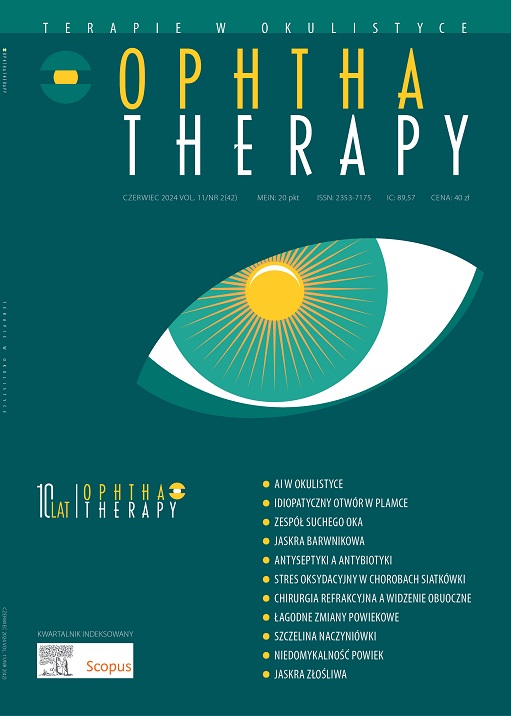Skuteczne działanie antyseptyczne w dobie antybiotykooporności w okulistyce Artykuł przeglądowy
##plugins.themes.bootstrap3.article.main##
Abstrakt
Nadmierne stosowanie preparatów antybiotykowych w codziennej praktyce okulistycznej, często bez wyraźnych wskazań medycznych, doprowadziło do rozwinięcia się niebezpiecznych szczepów bakterii opornych na dostępne leki. Obecnie antybiotyki standardowo są stosowane nie tylko w leczeniu infekcji, ale także w profilaktyce okołooperacyjnej, np. w zabiegu usunięcia zaćmy. Iniekcja doszklistkowa jest jedną z najczęściej wykonywanych procedur okulistycznych, podczas której do niedawna zalecano podawanie kropli o działaniu przeciwbakteryjnym. Współcześnie profilaktyczne zastosowanie miejscowej antybiotykoterapii w tej grupie chorych nie jest wskazane. W celu zapobiegania wystąpieniu powikłań infekcyjnych standardowo stosuje się jodopowidon oraz często preparaty łączące działanie antyseptyczne i łagodzące.
Pobrania
##plugins.themes.bootstrap3.article.details##

Utwór dostępny jest na licencji Creative Commons Uznanie autorstwa – Użycie niekomercyjne – Bez utworów zależnych 4.0 Międzynarodowe.
Copyright: © Medical Education sp. z o.o. License allowing third parties to copy and redistribute the material in any medium or format and to remix, transform, and build upon the material, provided the original work is properly cited and states its license.
Address reprint requests to: Medical Education, Marcin Kuźma (marcin.kuzma@mededu.pl)
Bibliografia
2. Ciulla TA, Starr MB, Masket S. Bacterial endophthalmitis prophylaxis for cataract surgery: an evidence-based update. Ophthalmology. 2002; 109: 13-24.
3. Pinna A, Usai D, Sechi LA et al. Detection of virulence factors in Pseudomonas aeruginosa strains isolated from contact lens-associated corneal ulcers. Cornea. 2008; 27: 320-6.
4. Sengupta J, Khetan A, Saha S et al. Candida keratitis: emerging problem in India. Cornea. 2012; 31: 371-5.
5. Kreslov MS, Castellarin AA, Zarbin MA. Endophthalmitis. Surv Ophthalmol. 1998; 43: 193-224.
6. American Academy of Ophthalmology. Bacterial keratitis preferred practice patterns.
7. Leaming DV. American Society of Cataract and Refractive Surgery: practice styles and preferences of ASCRS members: 2000 survey. J Cataract Refract Surg. 2001; 27: 948-955.
8. Kim SJ, Toma HS. Antimicrobial resistance and ophthalmic antibiotics: 1-year results of a longitudinal controlled study of patients undergoing intravitreal injections. Arch Ophthalmol. 2011; 129: 1180-8.
9. Yin VT, Weisbrod DJ, Eng KT et al. Antibiotic resistance of ocular surface flora with repeated use of a topical antibiotic after intravitreal injection. JAMA Ophthalmol. 2013; 131: 456-61.
10. Phan ADT. Intravitreal Injection Procedure.
11. Uhr JH, Xu D, Rahimy E et al. Current Practice Preferences and Safety Protocols for Intravitreal Injection of Anti-Vascular Endothelial Growth Factor Agents. Ophthalmol Retina. 2019; 3(8): 649-55. https://doi.org/10.1016/j.oret.2019.03.013.
12. 2018 Update on Intravitreal Injections: Euretina Expert Consensus Recommendations.
13. van Ketel WG. Allergic contact eczema by Hexomedine®. Contact Dermatitis. 1975; 1(5): 332.
14. Granel F, Lozniewski A, Barbaud A et al. Cutaneous infection caused by Tsukamurella paurometabolum. Clin Inf Dis. 1996; 23(4): 839-40.
15. Grare M, Dibama HM, Lafosse S et al. Cationic compounds with activity against multidrug-resistant bacteria: interest of a new compound compared with two older antiseptics, hexamidine and chlorhexidine. Clin Microbiol Inf. 2010; 16(5): 432-8.
16. Pinna A, Donadu MG, Usai D et al. In Vitro Antimicrobial Activity of a New Ophthalmic Solution Containing Hexamidine Diisethionate 0.05% (Keratosept). Cornea. 2020; 39(11): 1415-8. https://doi.org/10.1097/ICO.0000000000002375.
17. Pinna A, Donadu MG, Usai D et al. In vitro antimicrobial activity of a new ophthalmic solution containing povidone-iodine 0.6% (IODIM). Acta Ophthalmol. 2020; 98: e178-80.
18. Mencucci R, Favuzza E, Bottino P et al. A new ophthalmic formulation containing antiseptics and dexpanthenol: In vitro antimicrobial activity and effects on corneal and conjunctival epithelial cells. Exp Eye Res. 2020; 201: 108269. https://doi.org/10.1016/j.exer.2020.108269.
19. Hunyor AP, Merani R, Darbar A et al. Topical antibiotics and intravitreal injections. Acta Ophthalmol. 2018; 96: 435-41.
20. Grzybowski A, Told R, Sacu S et al.; Euretina Board. 2018 Update on Intravitreal Injections: Euretina Expert Consensus Recommendations. Ophthalmologica. 2018; 239(4): 181-93. https://doi.org/10.1159/000486145.
21. Avogaro F, Florido A, Calandri A et al. Intravitreal injections primary prevention: a case-control study. Eur Rev Med Pharmacol Sci. 2023; 27(8): 3664-9. https://doi.org/10.26355/eurrev_202304_32153.

